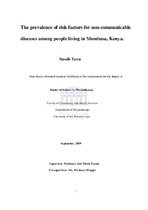| dc.description.abstract | Chronic non-communicable diseases, including cardio-vascular diseases and stroke, cancer, type 2 diabetes and chronic pulmonary disorders, are rapidly emerging as leading causes of morbidity and premature mortalities globally. The majority of the populations worldwide have experienced major transformations in disease profiles and health status characterized by a shift from infectious diseases and nutritional deficiencies to a predominance of chronic diseases of lifestyle. This epidemiological transition is regarded as an outcome of the environmental and
socioeconomic changes following urbanization.Common behavioral health risk factors, such as smoking, risky alcohol consumption,sedentarism, overweigh/obesity and hypertension, have consistently been attributed to the
development of chronic non-communicable diseases among populations.This thesis seeks to describe the epidemiology of the major common risk factors for noncommunicable diseases among people living in Mombasa, Kenya. The study responds to the WHO’S recommendations on comprehensive and continuous risk factor surveillance as an essential component of the public health information system and a vital health promoting strategy in the control and prevention of non-communicable diseases.A cross-sectional study design using the WHO STEPwise protocol was employed.Convenient stratification of the Mombasa population was done according to gender, age and setting categories. Using the Yamane formula n = N/1+ N(e²), a sample of 500 participants aged 15 to 70 years was arrived at. The researcher then conveniently selected public high schools, tertiary institutions, workplaces and a marketplace as the study settings.The WHO STEPS instrument (Core and Expanded Version 1.4) was used for data collection. Step 1 involved gathering information on socio-demographic characteristics and health-related behaviors of the participants using close-ended structured questions. Step involved the taking of simple anthropometrical measurements pertaining to height, weight, waist circumference, blood pressure and pulse rate.Data were captured, cleaned and analyzed using the Statistical Analysis System (SAS) and
SPSS version 16.0. Chi-square and Spearman correlation tests were used to determine associations between socio-demographic variables and behavioral health risk factors.The results indicated that 61% of the study participants possessed at least one of the investigated risk factors. 17% of the participants had a multiple risk factor profile, with 54% more females having a higher mean risk factor score compared to 46% of their male counterparts.Physical inactivity, hypertension and overweight/obesity were the most common registered risk factors, accounting respectively for 42%, 24% and 11%. Physical inactivity and hypertension formed the commonest cluster of multiple risk factor patterns; they co-occurred in 68% of the participants with a multiple risk factor profile.Increasing age, female gender and a low level of educational attainment were factors seen to be significantly associated with the development of risk factors for non-communicable diseases among the participants. It was observed that the burden of risk factors was unequally distributed among Mombasa residents; intervention programs based on our findings should therefore be used to ensure effectiveness. Future studies using nationally representative samples are further suggested to provide a more comprehensive analysis of a national risk factor profile. | en_US |

